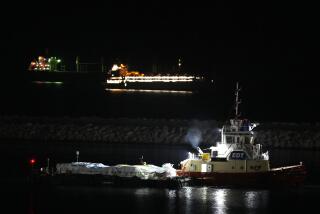Floating Islands, Cities and Airports Could Be the Wave of the Future : Environment: Some of the ideas discussed at a meeting on ocean technologies include offshore waste-disposal plants, condominiums and resorts. The idea is to ease stresses on land.
- Share via
HONOLULU — They barely stir a ripple now, but floating islands and cities could swell into a big wave of the future.
Many participants came away from a recent meeting here on ocean technologies and opportunities in the Pacific convinced that everything from waste-disposal plants to condominiums have a future at sea.
All of the ideas that were drifting around at the meeting have one thing in common: By utilizing the sea, planners hope to ease stresses on the land.
One of the most elaborate schemes--a “floating downtown,” just three miles off Honolulu--is envisioned by John Craven, an ocean engineering professor at the University of Hawaii.
It would include rotating condominiums, office buildings and industrial facilities. “The floating city would provide much-needed housing and ease development pressure in Hawaii, and it’s all doable,” Craven insists.
Another splashy plan proposes a 250-acre floating airport for San Diego. Located about three miles off Point Loma, the “floatport” would have two 12,000-foot runways and space for 80 airplane gates.
“The facility would probably be linked to the mainland by a tunnel or a bridge, although advanced hydrofoils or other stable watercraft might be considered,” said Howard L. Blood, chairman of the National Ocean Research Exploration Center, a nonprofit organization that supports the project.
An expanded floatport might also become a deep-water port that includes “hotels with full resort activities and subsurface cocktail lounges with underwater views of the natural sea life attracted to this man-made floating reef,” said San Diego architect Donald A. Innis.
In the architect’s concept, the $1.5-billion facility would be supported 20 feet above the water by a honeycomb of 30,000 large concrete cylinders that would make it impervious to wave motion.
Even floatport advocates concede that it’s a long shot. “There are land-based options for a new San Diego airport, and the floating concept has been pushed into the background, but we’re still hopeful,” Blood said.
Most floating-island advocates concede that before engineers plunge into elaborate offshore havens, they first must test the waters with less ambitious projects. One of the quickest ways to launch floating-structure concepts would be to start with building blocks that already exist.
“A lot of oil platforms aren’t being used now, and if there were a serious program, you could use them to demonstrate many aspects of this technology,” said Joseph R. Vadus, chairman of the the U.S. marine fisheries panel of the United States-Japan cooperative program in natural resources. “Big rigs such as semi-submersibles could be linked together to form floating islands.”
Some of these demonstration islands could be turned into garbage dumps. Trash, which already threatens to overwhelm many conventional landfills, could be put into closed containers and barged to oil-drilling platforms 20 to 100 miles offshore, suggests Michael A. Champ, president of Environmental Systems Development in Falls Church, Va.
Rather than being dumped at sea, the garbage would be converted into electricity and fresh water, using high-temperature combustion. The ash residue would be incorporated into the making of concrete blocks for artificial reefs that would attract fish.
Champ cites studies in Japan that show a tenfold increase in fish production after artificial reefs fashioned from coal-processing wastes were buried in offshore waters.
One of the most innovative floating islands on the drawing boards looks like a big blue doughnut. Domed with blue glass, it would cover about two acres and function as a working showcase for technologies that would thrive on future floating islands.
“We’d like to have our doughnut or something similar in the water off the state of Hawaii within the next 10 years,” said Patrick K. Takahashi, who directs the project and heads the University of Hawaii’s Natural Energy Institute.
Takahashi views his innovative floating island as an ocean version of the space station. “At $150 million,” he said, “it would be a bargain compared to the multibillion-dollar space station and would open a frontier that’s a lot more accessible.”
One of the most unusual floating islands under consideration would serve as a port of call for a virtual city aboard a ship. Scheduled for launch in 1995, the 250,000-ton cruise ship Phoenix World City, the largest ever built, would carry 6,200 passengers and 1,800 crew housed in three deck structures that look like floating condominiums.
“Our engineers are already looking ahead at floating islands,” said World City Corp. Chairman John S. Rogers, coordinator of the project. “The first would probably be a self-contained resort at sea for our cruise passengers.”
More to Read
Inside the business of entertainment
The Wide Shot brings you news, analysis and insights on everything from streaming wars to production — and what it all means for the future.
You may occasionally receive promotional content from the Los Angeles Times.










